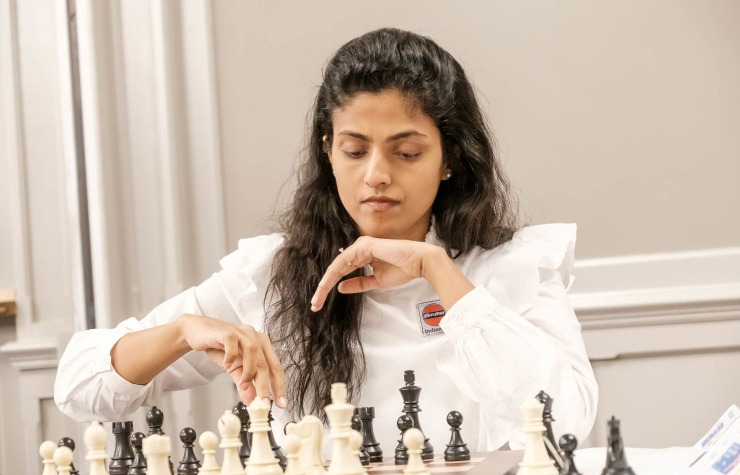The FIDE Chess.com Isle of Man Grand Swiss was a tournament like no other before: it was the first time that such a large number of top world players gathered for a Swiss competition. For 12 days the world chess elite – led by the World Champion Magnus Carlsen and World No 2 Fabiano Caruana, accompanied by a number of top world players – were battling in the Isle of Man for a $430,000 prize fund and (save for the World Champion and World No 2) for one place in the 2020 Candidates tournament.
The tournament ended with a Chinese victory, after GM Wang Hao defeated GM David Howell of England in the ultimate round, securing 8 points – the same as the World No 2 Fabiano Caruana – but winning first on better tiebreaks. The second place was taken by US GM Fabiano Caruana while six players tied for the third place (including the World Champion Magnus Carlsen), with Russian Kirill Alekseenko coming as the top among them.

Looking beyond individual results and games – what did the tournament show and bring to the chess world?
The approach to the games
There has been a large number of draws in this tournament – 441 out of 840 (52.5%), while 263 (31.3%) ended in a victory for White and 136 (just over 16%) were won by Black. Some interesting statistics provided by Arno Eliëns help us to see a broader picture.
There are many factors impacting the structure of the results: the ambitions of the players, how they felt on a particular day, how the positons developed, pairings, and also, the tournament system. In informal comments during the event, the prevailing view among the players was: the first three rounds were important to advance towards the top boards as much as possible, see how things develop in the middle and then either play safe or go into the games hard until the end. On a few occasions, games ended in a quick draw (with this option being limited by FIDE rules) and the number of quick draws was somewhat more noticeable among those players in the upper part of the standings who were not directly fighting for top places. Interestingly, the number of draws was lowest in rounds two and three (below 50%), reflecting the comments shared by the players about their approach.
The tournament was extremely strong, so there were no “lesser” opponents, even though the elite had to face players who were below their rating range. According to GM Aleksander Colovic who analysed the games for the British Chess Magazine, “this led to different approaches: some didn’t mind playing in the same way, thus making a lot of draws (Wesley So being a typical example), while others like Carlsen and Grischuk took risks and were on the verge of losing several times (in Grischuk’s case he even lost twice)”.
The format of an open tournament forces most of the elite players out of their comfort zone as it imposes the extra pressure to “have to win” when playing lower-rated opponents and this gives these lower-rated opponents their chances.
The second part of the tournament saw an increase in the number of draws as the players were becoming more cautious. “Generally speaking in modern times the tendency to avoid risks in the last rounds is notable. Petrosian was famous to make draws in the last rounds no matter what the tournament situation was and it worked for him. Today it appears as if all of them are like Petrosian”, noted Colovic.
This can be attributed to the bigger importance of the prize money, a draw securing a good prize, which is preferable to the risk or playing for glory and first place but then losing and getting nothing. “Perhaps the young players should be reminded of the famous quote by Lasker on what a champion must have: “The passion that whips the blood when great stakes can be gained by resolute and self-confident daring”, argued GM Aleksandar Colovic.
Despite the fact that players had 100 minutes each for first 40 moves, followed by 50 minutes for the next 20 moves, followed by 15 minutes for the rest of the game, with an increment of 30 seconds per move from the start, each round saw a number of games in which players ended in time trouble, especially towards the top boards, which, for most players and the media and the wider audience was a source of great excitement.
Given the structure of the contestants (especially looking at the top tier of participants), we have seen players demonstrate extremely high levels of preparation, often finishing well after the 20th move. The chess.com live commentary and analysis, which was provided alongside the games, has shown that in the majority of cases, especially on the top 20 boards, players did play similar to the levels of top computers.
With 840 games played in what is arguably the strongest Swiss event ever held in chess history, the FIDE Chess.com Grands Swiss will be an abundant resource for chess theory and further game and play analysis.
The players
Altogether 154 players from 42 countries took part, most notably – Russia (26), India (15), United States (12) and Ukraine (10). When it comes to tiled players, there were 133 GMs, two women GMs, and 16 IMs. With the world’s No 1 and No 2 present and with some of the strongest top players in the world, the tournament had the average ELO of 2630.
The tournament has seen a great number of players complete norms, including two countries getting their youngest GMs ever: Vincent Keymer (14) of Germany and Jonas Buhl Bjerre (15) of Denmark. The youngest player to achieve his final GM norm was the 13-year-old Indian Raunak Sadhwani. At 13 years, nine months and 26 days, Sadhwani became the ninth youngest player in the world to reach the GM title and India’s 65th GM.
Altogether, 18 women players took part in the event. Indian GM Harika Dronavalli was the most successful female participant, having achieved 5.5 points out of 11 games all played with GMs. The highest-rated woman player at the event, Dronavalli started in the 122nd place and finished 83rd. She gained 23 points and her performance level was 2651. Kazakh player Dinara Saduakassova has tied for the first place among women with Dronavalli (with 5.5/11 each; but the Indian had a better tiebreak). Her rating has gone up to 2505, and she is 11th in the list of the best women chess players.

The organization
The event saw FIDE partnering with a private organizer to create a tournament which was part of the official cycle for selecting the next challenger for the title of World Champion. Under the official name “The FIDE Chess.com Grand Swiss 2019”, the tournament was organized by IOM International Chess Limited which has hosted the previous Isle of Man chess opens. The primary goal of the event was to fill in one of the eight places in the Candidates tournament which will be played in the Russian city of Yekaterinburg in March-April 2020.
Apart from the Grand Swiss, there were also a Major and a Minor tournaments, open to all other players.
A very substantial prize fund, provided by the organizers, reached $433,000. Unlike the previous Isle of Man tournaments, which were held in the Villa Marina and Gaiety Theatre in Douglas, this year’s event took place in the Comis hotel which is located just outside of Douglas and proved to have adequate facilities to house players and provide good conditions for preparation and play.
The arbiters’ team, headed by Alex Holowczak, was supported by the Fair Play team headed by Andrew Howie. During the tournament, the Fair Play team piloted new equipment for making sure there are no irregularities, including new software which could help detect if there was an electronic device operating in or immediately next to the playing hall.
Overall, the tournament was well organized and there were no official complaints, which was confirmed by the FIDE Supervisor Jeroen van den Berg who branded the event as ‘a success’.
FIDE has confirmed it will continue to explore and develop the partnership model used in the Isle of Man – running events through partnering with organizations that have a proven track record and support in the chess community.
The media coverage and reception
The FIDE Chess.com Isle of Man Grand Swiss was followed by a wide chess audience all around the world through four main channels: the official website of the tournament, the chess.com live coverage of the event which daily attracted tens of thousands of live viewers, Twitch, and the news section of the FIDE website which featured daily reports and interviews, as well as press releases of the official global chess body.
News and reports about the event appeared not only in chess media but in news media – in the UK, Ireland, several other European countries (Denmark, Germany, Russia, Spain) as well as in India, Iran, China, the US, and Latin America.
The number of the world top players taking part and the presence of the World Champion and World No 2 were important contributing factors increasing the interest of the news media.
Text: Milan Dinic
Photo: John Saunders and Maria Emelianova/Chess.com







